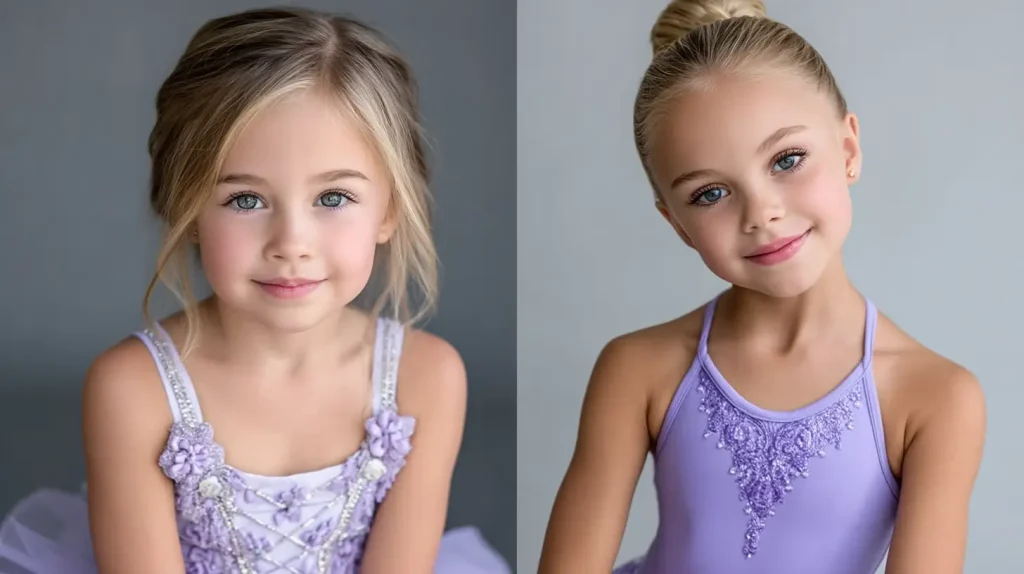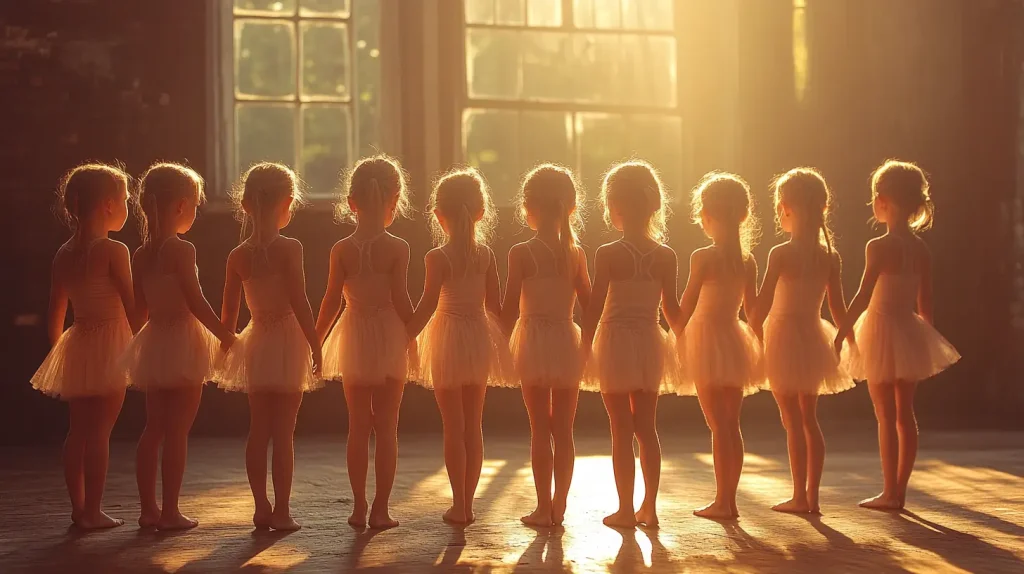Deciding whether ballet or gymnastics is best for your child can be a challenging decision. This article breaks down the key differences, benefits, and considerations to help you make an informed choice.
Graceful Insights
- Ballet and gymnastics are distinct disciplines; ballet focuses on artistry and technique, while gymnastics emphasizes strength, flexibility, and precision.
- Both activities offer unique benefits: ballet promotes self-expression and discipline, while gymnastics fosters physical fitness and enjoyable routines.
- Parents should consider their child’s interests, aspirations, and personality traits when choosing between ballet and gymnastics, as both require significant time and financial commitments.
Ballet vs Gymnastics Podcast
| Aspect | Ballet | Gymnastics |
|---|---|---|
| Focus | Emphasizes grace, precision, and expressive dance movements. | Centers on strength, flexibility, balance, and acrobatic skills. |
| Physical Benefits | Enhances flexibility, balance, posture, and lower body strength. | Develops overall strength, particularly in the upper body and core, as well as agility and coordination. |
| Age to Start | Suitable to begin at any age, foundational training can start in early childhood. | Starting at a young age (as early as 2) is ideal to build muscle memory and flexibility. |
| Variety | It offers multiple styles, including ballet, tap, jazz, and hip-hop, allowing for the exploration of different forms. | Includes disciplines such as artistic, rhythmic, trampoline, and tumbling, although specialization is common. |
| Creativity | Encourages self-expression and creativity through movement and storytelling. | Focuses more on technical skills and precision, rather than creative expression. |
| Social Interaction | Provides opportunities for group performances and teamwork, fostering social skills. | While training is often individual, team events and group sessions build camaraderie. |
| Longevity | It can be pursued recreationally or professionally into adulthood. | Typically, it has a shorter athletic lifespan due to physical demands; many retire in their mid-20s. |
| Cost Considerations | It may involve expenses for various costumes, specialized footwear (e.g., pointe shoes), and recital fees. | Costs include uniforms and potential competition fees; however, fewer costume changes may result in lower expenses. |
Ultimately, the best choice depends on your child’s interests and personality. Balancing might be more suitable if your child enjoys music, rhythm, and creative expression. Conversely, gymnastics could be better if your child is inclined toward physical challenges and acrobatics. Observing your child’s natural inclinations and discussing their preferences can guide you to the most appropriate choice.
Understanding Ballet and Gymnastics

Although ballet and gymnastics may initially seem similar, they are distinct in many ways. Ballet is an ancient art form with deep cultural roots. Much of its vocabulary is in French, reflecting its historical significance.
Ballet dancers focus on rhythm and tempo, often performing classical music, which is essential for creating the desired aesthetic. Proper ballet training from a young age helps cultivate passion and ensures physical readiness for advanced techniques, such as pointe work in classical ballet. The way ballet, costumes, and dances are choreographed also highlights the unique qualities of this art form.
Gymnastics, on the other hand, is a sport that emphasizes strength, flexibility, and coordination. Rhythmic gymnastics, a popular discipline, is an art that combines elements of ballet, dance, and apparatus manipulation, creating a dynamic and visually captivating performance. Competitive rhythmic gymnastics requires rigorous training and focuses on events like floor routines, vaults, and bars, each demanding explosive power and precision.
Both disciplines require significant dedication, but their training methods and physical demands differ notably. Ballet dancers spend countless hours perfecting their posture, grace, and fluidity of movement, while gymnasts build explosive power, core strength, and agility. Understanding these fundamental differences can help parents and children make an informed choice about which path to pursue.
Benefits of Ballet for Children

Ballet offers children numerous benefits, starting with the mastery of foundational techniques. The five basic positions in ballet are essential for developing proper posture and executing movement effectively. These foundational skills lay the groundwork for more advanced choreography and movement patterns, ensuring that young dancers grow with a solid base.
Ballet classes foster self-expression and creativity through movement, offering benefits that extend beyond the physical realm. In a dance class at a dance studio, children learn to communicate emotions and stories through their bodies, enhancing their artistic abilities and confidence. This creative outlet is vital for personal growth and can have a positive impact on other areas of their lives.
Ballet also instills self-discipline in children. As they progress through dance lessons, they learn to manage their behavior, follow instructions, and commit to regular practice. These lessons in discipline and perseverance are valuable life skills beyond the first dance class or studio. When children are ready, they can start dancing to enhance their skills.
Advantages of Gymnastics for Kids

Gymnastics provides a robust foundation for physical fitness in children. Regular gym practice also improves muscle strength, endurance, and physical conditioning. The rigorous training routines in gymnastics ensure that kids develop a strong and healthy body, which can benefit them in various other physical activities and sports.
Gymnastics training emphasizes upper body and core strength, particularly for events like vault and bars. These routines require gymnasts to build significant strength and stability in their legs, core, and upper body, enhancing their overall athleticism. This emphasis on strength is complemented by the need for explosive power and speed, especially in floor exercises and vaulting.
Beyond its physical benefits, gymnastics is also incredibly fun and engaging for kids. The sport’s dynamic nature, entertaining routines, and varied apparatus keep children motivated and excited about their training and performance. This enjoyment can foster a lifelong love for physical activity and help children develop a positive attitude toward fitness.
Comparing Training Routines
The training routines in ballet and gymnastics are tailored to the specific demands of each discipline. Ballet training focuses on developing overall body coordination and posture. Gymnasts require environments with mirrors and proper flooring to minimize the risk of injury. Ballet classes for gymnasts are structured to ensure dancers progress through skill levels methodically, emphasizing technique and grace.
In contrast, gymnastics training involves bars, beams, and trampolines, typically conducted on spring or padded floors to absorb impact. This training style places a strong emphasis on upper body, core strength, and explosive power, which are essential for performing dynamic routines. Both disciplines require structured gym environments, but the type of equipment and focus areas differ significantly.
Despite these differences in style, ballet and gymnastics emphasize skill progression and dedication. Whether perfecting a ballet routine or mastering a gymnastics trick, children in both activities benefit from structured training environments that foster discipline and a strong work ethic.
Age Considerations for Starting
The starting age is crucial when deciding whether to teach your child ballet or gymnastics. Children can start ballet classes as early as three to four years old. At this age, they can develop foundational skills such as coordination and balance, which are essential for advanced ballet training. Serious ballet and gymnastics training often begins around eight to ten years old, allowing children to build on their early experiences and develop more complex techniques.
Gymnastics also welcomes young participants, with children starting as early as two to three years old. This early introduction helps students develop flexibility, strength, and motor skills. Both ballet and gymnastics require years of practice to perfect students’ specific skills, making starting at a young age beneficial.
Parents should consider their child’s long-term aspirations and interests when choosing between these activities. Trial classes can be an excellent way to gauge a child’s interest and aptitude before making a commitment. It’s also important to note that children can switch from gymnastics to ballet or vice versa after several years of training, providing flexibility in their developmental journey.
Balancing Both Dance and Gymnastics

For some children, pursuing both ballet and gymnastics can be a rewarding experience. Whether a child can balance both activities depends on their level of commitment and the level of competition. Adding dance to a gymnast’s routine can enhance performance by improving the grace and fluidity of movement. Conversely, the strength and coordination developed in competitive gymnastics can also benefit ballet dancers.
Participating in both activities can help children develop versatility for various sports in the future. The skills learned in ballet, such as posture and balance, complement the strength and agility required in gymnastics and dance. This cross-training approach can foster a well-rounded athletic capability.
Parents may consider allowing a trial period for their child to explore both activities before making a long-term decision. This exploratory phase can help children identify their preferences and passions early, ensuring they commit to an activity they genuinely enjoy.
Potential Drawbacks and Risks
While ballet and gymnastics offer numerous benefits, they also have potential risks. A solid foundation in ballet is essential for injury prevention and skill progression, emphasizing key elements such as posture, strength, and balance. However, young dancers often face risks related to growth and development, which can increase the potential for injury if they perform advanced techniques too early.
Gymnastics is particularly tough on joints, often resulting in long-term joint damage from impacts during routines. The high-impact nature of gymnastics can lead to chronic injuries, underscoring the importance of proper technique and training under the guidance of qualified instructors. Both disciplines require a high level of physical commitment, which can be physically demanding and lead to mental burnout in young athletes.
Gymnastics training often includes mental conditioning to overcome fears associated with high-impact routines. Similarly, ballet can lead to chronic overuse injuries due to its high demands on the body, especially on the toes and feet. Understanding these risks can help parents make informed decisions and ensure their child’s safety in either discipline.
Choosing Based on Personality and Interests
A child’s natural inclinations and personality traits play a significant role in deciding whether ballet or gymnastics is better for them. Parents can guide their child’s choices by observing their enjoyment of specific activities. If a child is passionate about dance and music, ballet might be the ideal choice. Conversely, gymnastics could be a better fit if a child enjoys physical challenges and dynamic movements.
Letting a child try both ballet and gymnastics helps them gravitate toward the discipline they enjoy most. Parents should consider letting their children try a few sessions of each discipline before making a decision. This approach allows children to explore their interests and develop a passion for the most fulfilling activity.
Participating in gymnastics and dance also supports the development of social skills through teamwork, peer interaction, and teacher guidance. Regular attendance in ballet classes boosts children’s confidence and self-esteem by helping them appreciate their abilities. Ultimately, the choice should align with the child’s natural affinity, interest, and enjoyment.
Cost and Commitment Comparison
Both ballet and gymnastics involve significant financial and time commitments. Ballet classes can be expensive, accumulating costs from class fees, costumes, and recitals. The financial commitment required for ballet can be substantial, especially if a child pursues it seriously.
Gymnastics training often requires more frequent sessions, which can lead to increased financial and time commitments compared to ballet. The cost of equipment, competitions, and training facilities can add up quickly. Parents must weigh these factors and consider their family’s budget and schedule when deciding between the two activities.
Ultimately, the decision should balance the financial and time commitments with the child’s and teacher’s interest and passion for the activity. This careful consideration ensures that the chosen discipline aligns with the child’s lifestyle and family resources.
Success Stories and Role Models

Success stories and role models in ballet, dance, and gymnastics can inspire young athletes to pursue their dreams and aspirations. For example, Oriel Copeland has performed with several prestigious dance companies and considers dancing at QPAC one of her top achievements. Such role models showcase the heights of achievement possible through dedication and practice.
In gymnastics, Olga Korbut became an Olympic sensation at the 1972 Munich Games, leaving a lasting legacy in the sport of rhythmic gymnastics. Similarly, Caliese McEachern competed internationally in Acrobatic Gymnastics, achieving notable placements in competitions in Las Vegas and Portugal. These stories highlight the possibilities that await young gymnasts who commit to their training and dedication.
Paige McKay, accepted into the Bachelor of Musical Theatre program immediately after high school, showcases how early talent and dedication in ballet can lead girls to significant opportunities. Role models in both disciplines inspire young girls and athletes to strive for excellence and follow their passions.
Resume
In summary, both ballet and gymnastics offer unique benefits and challenges. Ballet fosters grace, posture, and artistic expression, while gymnastics builds strength, agility, and dynamic movement. Understanding these differences, training routines, age considerations, and potential risks can help parents make an informed decision.
Ultimately, choosing music, ballet, and gymnastics should align with the child’s personality, interests, and long-term aspirations. Whether they pursue one or both activities, the journey will undoubtedly be filled with growth, learning, fun, and memorable experiences.









